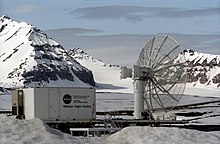SvalRak
Spitsbergen |
SvalRak (short for Norwegian: Svalbard Rakettskyttefelt ) is the name of a launch site for sounding rockets near Ny-Ålesund on Spitsbergen . The installation of the launch site cost 7.4 million Norwegian crowns . The place is ideally suited for launching rockets to investigate the earth's magnetic field . In addition, due to its location, it is the only rocket launch site in the world where rockets can soar into the dark polar night sky even at lunchtime .
SvalRak has been in operation since November 3rd, 1997. On November 20, 1997, the first research rocket, an Indian RH-300 , took off under the project name "ISBJØRN-1" (German: Eisbär-1) , but did not reach the planned height. On the same day, a US Viper 3A took off as "ISBJØRN-2"; it was SvalRak's first successful rocket launch.
During the third launch, on December 2, 1997, a Canadian Black Brant 9, which was launched for NASA , reached an altitude of 433 km and thus crossed the border into space .
The altitude record that is still valid today was set at the fifth launch of SvalRak when a two-stage Japanese rocket of the type SS-520 reached an altitude of 1108 km on December 4, 1997 .
Web links
- SvalRak in the Encyclopedia Astronautica (English)

Coordinates: 78 ° 55 ′ 52 ″ N , 11 ° 51 ′ 0 ″ E
